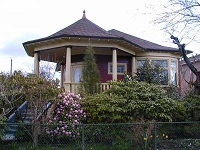On April 13, 1892, almost exactly a year after receiving its name, South Vancouver was formally incorporated. Upon incorporation the District of South Vancouver stretched from Boundary Road on the east, to Point Grey on the west. It encompassed all of what is now Collingwood, Cedar Cottage, Fraserview, Marpole, Dunbar and West Point Grey. The original Village of South Vancouver grew up around the south ends of Main and Fraser Streets. District offices were located in the Village until 1929 when South Vancouver amalgamated with the City of Vancouver.
In 1893, there were only 500 male voters in all of South Vancouver. This was enough to convince the B.C. Electric Railway to build a one-track streetcar line down Fraser Street to the small Village on the south slope. By 1909, there were about 5,000 people in South Vancouver and by 1910 that number had nearly tripled. Due to the area's industrialization and subsequent housing boom, the population of South Vancouver had reached approximately 35,000 in 1911. Land that had been bought for a dollar an acre, was being subdivided and sold for $5,000 a lot along the Village's business section (the 10 blocks between 41st and 51st Avenues on Fraser Street).
Throughout the 1920s, South Vancouver development was more restrained. After amalgamating with the City of Vancouver in 1929, the area maintained a rural flavour until after WWII. In the late 1940s, agricultural land was used to house returning veterans. As families continued to move to the area, new schools and community centres; were built. In 1950, John Oliver Secondary School was built on Wilson Park, the site of an old South Vancouver farm. That same year Sunset residents saw five years of lobbying come to fruition with the completion of the Sunset Memorial Community Centre.
Did you know?
- The area was originally called South Hill by early residents.
- Bing Crosby opened the Sunset Community Centre in the 1950s.

 Sunset
Sunset With much of the community's housing built after WWII it is not surprising that there are only a few notable heritage buildings in Sunset. As of June 1992 there were 35 structures listed on the Vancouver Heritage Register. Of particular significance is the Field House built circa 1930 in Memorial Park South. Nestled in a grove of mature trees, this low gabled structure contributes to the overall park design and landscaping. Designed in a rustic English Arts and Crafts style, the building features board and batten siding, multi-paned casement windows, and a porch with heavy timber brackets.
With much of the community's housing built after WWII it is not surprising that there are only a few notable heritage buildings in Sunset. As of June 1992 there were 35 structures listed on the Vancouver Heritage Register. Of particular significance is the Field House built circa 1930 in Memorial Park South. Nestled in a grove of mature trees, this low gabled structure contributes to the overall park design and landscaping. Designed in a rustic English Arts and Crafts style, the building features board and batten siding, multi-paned casement windows, and a porch with heavy timber brackets.